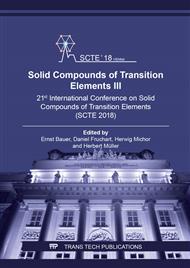[1]
J. Etourneau, Critical survey of rare-earth borides: Occurrence, crystal chemistry and physical properties, J. Less-Common Met. 110 (1985) 267 – 281.
DOI: 10.1016/0022-5088(85)90333-9
Google Scholar
[2]
T. Tanaka, S. Okada, Y. Yu, Y. Ishizawa, A New Yttrium Boride: YB25, J. Solid State Chem. 133 (1997) 122 – 124.
DOI: 10.1006/jssc.1997.7328
Google Scholar
[3]
T. Tanaka, S. Okada, Y. Ishizawa, A new yttrium higher boride: YB50. J. Alloy. Compd., 205 (1994) 281 – 284.
DOI: 10.1016/0925-8388(94)90802-8
Google Scholar
[4]
T.B. Massalski (Editor-in-Chief), Binary Alloy Phase Diagrams, 2nd Ed. plus updates, ASM International, ASM CD-ROM, Ohio, USA (1996).
Google Scholar
[5]
A. Taran, D. Voronovich, N. Shitsevalova, A. Levchenko, V. Filipov, S. Abashin, Phase transformations in lutetium borides at heating in vacuum, Solid State Phenom. 464 (2011) 172 – 174.
DOI: 10.4028/www.scientific.net/ssp.172-174.464
Google Scholar
[6]
D. Voronovich, A. Taran, N. Shitsevalova, A. Levchenko, V. Filipov, Anisotropy of the erbium dodecaboride thermionic properties, Solid State Sci. 14 (2012) 1624 – 1628.
DOI: 10.1016/j.solidstatesciences.2012.04.009
Google Scholar
[7]
D. Voronovich, A. Taran, N. Shitsevalova, A. Levchenko, V. Filipov, Thermal instability of holmium and thulium dodecaborides in vacuum, Solid State Phenom. 257 (2017) 152 – 155.
DOI: 10.4028/www.scientific.net/ssp.257.152
Google Scholar
[8]
G. A. Meerson, N. N. Zhuravlev, R. M. Manelis, A. D. Runov, A. A. Stepanova, L. N. Grishina, N. V. Gramm, Some properties of yttrium borides, Izv. Akad. Nauk SSSR, Neorgan. Materialy 2 (1966) 608 – 616 [in Russian].
Google Scholar
[9]
G. V. Samsonov, L. N. Okhremchuk, I. A. Podchenyaeva, V. S. Fomenko, V. V. Odintsov, Thermoemission of transition metal dodecaborides, Izv. Akad. Nauk SSSR, Neorgan. Materialy 10 (1974) 270 – 272 [in Russian].
Google Scholar
[10]
J. Jaskie, D. Jacobson, Thermionic emission and surface composition of the Y – B system, J. Energy 5 (1981) 187 – 189.
DOI: 10.2514/3.62524
Google Scholar
[11]
A. Czopnik, N. Shitsevalova, V. Pluzhnikov, A. Krivchikov, Yu. Paderno, Y. Onuki, Low temperature thermal properties of yttrium and lutetium dodecaborides. J. Phys.: Condens. Matter 17 (2005) 5971 – 5985.
DOI: 10.1088/0953-8984/17/38/003
Google Scholar
[12]
L.N. Dobretsov, M.V. Gomoyunova, Emission Electronics, Israel Program for Scientific Translations, Jerusalem, 1971, 433 p.
Google Scholar
[13]
K. Takahashi, S. Kunii, Single crystal growth and properties of incongruently melting TbB6, DyB6, HoB6, and YB6, J. Solid State Chem. 133 (1997) 198 – 200.
DOI: 10.1006/jssc.1997.7427
Google Scholar


